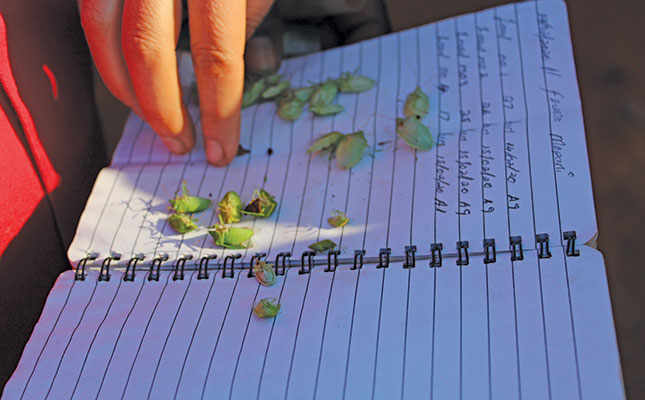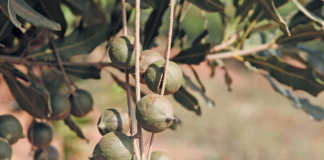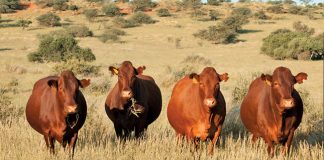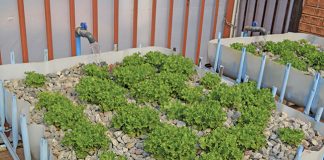
Photo: Lindi Botha
Plagued by stink bug populations that seem to multiply despite increased pest control application, the macadamia industry in South Africa is losing R200 million a year to insect pest damage. This damage is related to unsound kernel, a condition where the macadamia nut in the shell is damaged by insects while ripening on the tree.
Many farmers have reacted by applying ever more pesticide, which has only served to exacerbate the problem as natural predators to harmful insects are also eliminated, detrimentally affecting the entire ecology within orchards.
One of South Africa’s largest macadamia production areas, Levubu in Limpopo, happens to be home to 14 bat species. This, coupled with the economic significance that bats could offer macadamia farmers, led Dr Valerie Linden, from the Centre for Invasion Biology at the University of Venda, to conduct research that could eventually see bats protected and nurtured by the agricultural community.
“Bats are known to be active in South African macadamia orchards and to feed on major insect pest species, like the green vegetable bug (Nezara viridula), macadamia nut borer (Cryptophlebia ombrodelta), two‐spotted stink bug (Bathycoelia natalicola) and litchi moth (C. peltastica),” says Linden.
“What we didn’t know was just how much of the pest insect population these bats consumed, which is what we set out to study.
“In Levubu, many other crops or even areas of natural bush are being removed and replaced with macadamias. The crop is highly valuable, so it’s an ideal species to study if you want to look at the economic impacts of the presence or absence of biocontrol agents such as bats. Macadamias are under high insect pressure, which was another criterion.
“We ultimately found that farmers could save as much as R76 300/ ha in reduced nut damage as a result of bats keeping stink bugs under control.”
Linden believes that converting the value of bats to rands and cents will go a long way towards protecting these mammals.
“Many people are unaware of the benefits provided by bats as well as their general presence, so they’re hardly missed, and declines in their numbers aren’t noticed directly.”
She adds that bats also reproduce slowly, having only one pup a year, so the recovery of a population can take much longer than for rodents, for example. It is therefore important to make people aware of their value and the services they provide so that everyone has an interest in protecting these animals.
“Pest control is important not only for agriculture and food production, but for disease control, as bats eat malaria-causing mosquitoes. They’re also pollinators and seed dispersers.”
Nature knows best
For the study, Linden created a scenario where bats and birds were absent from macadamia trees.
Cages were constructed around macadamia trees enclosed with nylon mesh net that would keep larger animals out, but would let insects through to gain access to the trees.
To distinguish between the effects of bats and birds, some cages were closed at night, others were closed during the day, and a third set was closed all the time. Control trees were not enclosed at all. Linden then monitored the effect on insect populations, yield and nut quality.
“We also compared trees at the orchard edge next to natural or semi-natural vegetation with trees further inside the orchard, away from any natural habitat. I monitored bat activity over three years through acoustic monitoring using bat detectors and monthly insect counts on the macadamia trees, and assessed quality and yield at the end of each season, identifying defects caused by different insects.
“We found that bats, as well as birds, have a massive impact as biocontrol agents. Their absence results in reduced quality and up to 60% decrease in yield.”
Linden also found that the impact of bats as natural pest control in macadamias was higher in trees close to natural habitat than in trees away from any natural vegetation. Benefits could be seen up to 530m from the natural vegetation.
“Although these patches of natural vegetation can also create problems as they’re a habitat for crop raiders such as monkeys, my results showed that the benefits coming from these patches by far outweigh the disadvantages. Savings through higher biological control by bats and birds near these natural edges, which were up to R76 500 per season in the studied area, are much higher than the measured losses through crop raiding by monkeys, which was around R24 500.”
The enclosure where bats and birds were both excluded produced the lowest nut set, followed by day exclusion and then night exclusion.
The exclusion of both bats and birds resulted in a 60% decrease in yield compared with the control. The exclusion of both bats and birds therefore resulted in an income loss of around R76 300/ ha. The reduced income losses for the exclusion of diurnal birds totalled around R60 200/ ha, and for bats and nocturnal birds about R37 000/ha.
To further highlight the ability of bats to assist with pest control, Linden recorded bat numbers throughout the year and found that an increase in bats correlated with the macadamia nut season.
The highest (March and May) and lowest (November and August) average numbers of bats recorded during the study overlapped the high (December to the end of May) and low (June to the end of November) seasons of insect pest loads in macadamia orchards, with bat activity nearly doubling in the high season.
creating a bat-friendly environment
While bats have proved their worth in macadamia orchards, keeping their numbers sufficiently high is a challenge. An ever-growing human population and related land use changes, especially agricultural intensification, have led to a threat of extinction of about one quarter of bat species globally.
Linden notes that the loss of roost sites caused by land-use changes is one of the major drivers of this decline, and there is a particular lack of knowledge regarding roost site preferences of African bat species.
“The importance of landscape features and connectivity within an agricultural landscape for bats has been proved. It’s therefore recommended that farmers increase or at least maintain the amount of natural vegetation around agricultural areas, considering the significantly higher pest control services. Other ecosystem services, such as pollination, could also be enhanced by natural vegetation and be compromised by its removal or isolation.”
Linden believes education is an important tool in protecting natural areas around agricultural land, highlighting the valuable benefits, which can outweigh its costs.
“It’s important to make growers aware of threats as well as economic benefits that natural areas pose for them as they can play an important role in species conservation.”
Managing bats
The proactive management of bat populations is indispensable to sustaining the ecosystem services they provide. This means that farmers need to follow a combination of practices, which include decreasing pesticide use, leaving natural habitats intact and erecting bat houses.
“Bats are known to be more active on organic farms as they’re sensitive to pesticide, which not only affects them, but kills off their food source. Bats rely heavily on natural roost sites, like large indigenous trees, so habitat conservation and connectivity are important. If their natural habitat disappears, so will bats.”
Linden cautions that while Levubu farmers are fortunate in that the bat diversity is particularly high in this area, she found evidence that clutter-feeding bat species, which are generally more sensitive to disturbances and pesticide application, are more or less absent from the orchards.
“So although bats are around the orchards, farmers need to be aware how management practices can affect natural predators.
“To further promote bird and bat populations and thereby potentially increase the value of biological control, artificial nesting and roosting sites can be provided to encourage bats to inhabit agricultural areas, where natural habitat is scarce. This can be more cost-efficient than pesticide treatments in keeping pest species under a certain threshold.”
Unfortunately, artificial roosts, such as bat houses, cannot entirely replace natural roosts, as they are suitable only for some species. Linden has found, however, that bat houses are a good way to establish large colonies of certain bats around orchards.
She advises farmers to take care when purchasing bat houses, as not all are suitable.
“The most important aspect is durability. It can take up to five years for bats to occupy a house, so ideally your bat house must be able to last longer than that.”
She notes that while bats are not a complete solution to pest insect problems in orchards, and like any other predator cannot completely eliminate pests, they can control them effectively.
“If you can establish a healthy bat population on your farm, pest numbers and, with that, the need for pesticide, will go down. This, in turn, might increase bat activity in the orchards and pest numbers will decrease further.”
Email Dr Valerie Linden at [email protected].











